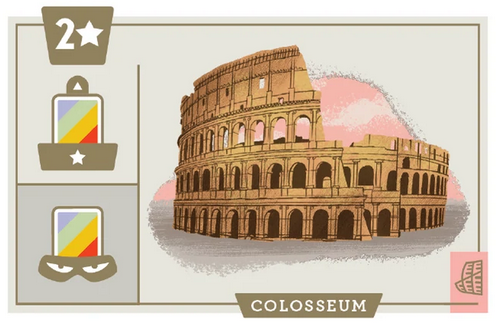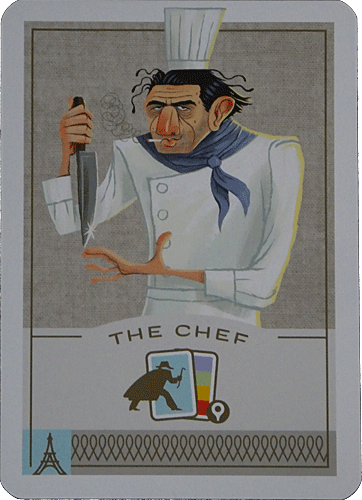
Caper in slang is any kind of shady activity – and this game is full of them.
It’s a card drafting game (one in which you take up and place cards) designed by Unai Rubio in which players strategically build themselves a team of thieves, equip them with “gear” (paraphernalia), and try to take control of areas that represent potentially lucrative sites across Europe.
It was upgraded and expanded by Keymaster Games in 2021.
Each game is based in one of four European cities – you choose which, depending on how tricky to play you want the game to be.
Because the locations bring different benefits and opportunities, the game changes depending on whether you’re playing in Paris, London, Barcelona, or Rome.
At Rome’s Colosseum for example, the effects shown on the card are ….
► gain 2 points at EndGame if you can take control of the location
► get 1 point for each gear card that your opponent dropped off here
► increase your chances of controlling the location by dropping gear here
Now there’s a conundrum – do I try to gain control by dropping gear? But if I don’t get control, my opponent will get a point for every piece of gear I’ve dropped. Oh dear!

This variety of locations makes for a different game every time you play, especially when combined with the fact that thieves and gear cards appear in unpredictable order in each game.
Further, some thieves and their gear only turn up in certain cities – not everywhere!
The colourful rogues on Caper’s cards are lively and fun. They’re delightfully drawn by Josh Emrich, beautifully bringing out their shifty and malignant characters.
As an example, you’ll have the pleasure of meeting this cheerful looking chappie
when you’ve chosen to base the game in Paris.
Players make challenging decisions about which thieves to use, where to locate them,
and what gear to give them.
That sounds simple, but it’s not. From the outset, players are confronted
with chin-stroking choices.
OK, you choose and locate your first thief ~ you might have chosen the chef (does anyone come to mind?) and decided to drop him off at Louvre, but what might come next?
Ummmm !

Having placed your choice of available thieves, all your remaining thief cards are then passed to your opponent and theirs to you. So they know what potentially good or rubbish cards they’ve passed to you ~ and vice versa.
Each of you chooses and places another, and then you exchange hands again!
It continues thus, back and forth, as both thieves and gear are dished out.
There are no movements. Caper is about placement – putting the thieves and their gear where they can gain most for you and, if possible, do your opponent most harm.
That’s SO nasty! Criminal, almost!
Caper runs over six turns, alternating between having a few thieves to select & place, followed by a few gear cards.
The thieves’ characteristics vary considerably, as do their effects on play, location control, and eventual scoring. The same applies to their gear.
It’s important to attend closely to what each can do whilst making decisions about who or what to place where. This is where the pictorial ‘guides’ on the cards are so crucial – and Keymaster’s online guide is an excellent aid.
Here is Keymaster’s excellent guide to thieves, gear, and cities.
- each card pictorially displays what effects and qualities thieves and gear have
- couple of minutes of setting up
- strategic thinking does come, once you get a feel for what you’re up to
- a lowish level of luck is involved, but choices matter most
- somewhat combative ~ with a touch of area control
- needs a bit of quiet care when it comes to doing the final adding up


